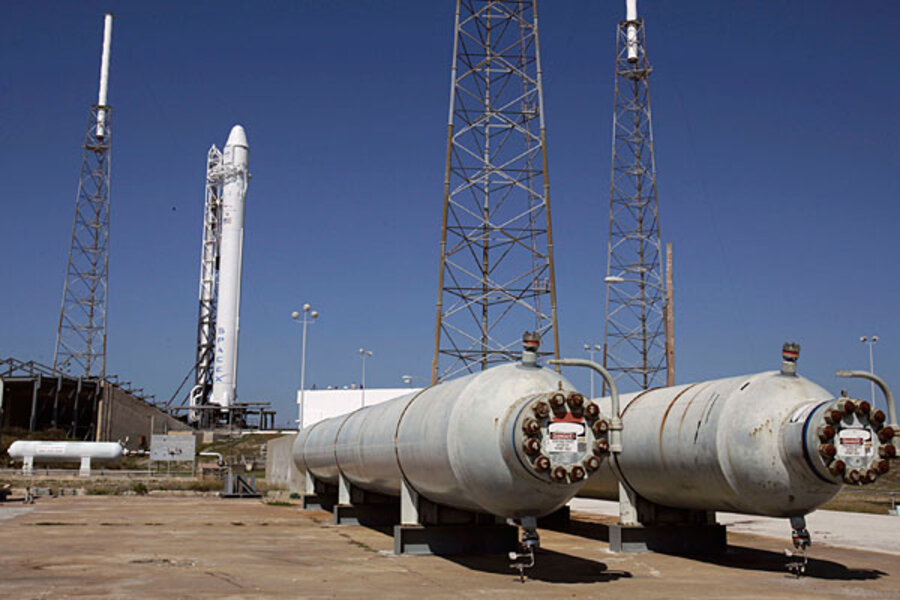Why historic SpaceX mission to space station will be so difficult
Loading...
A slender white rocket with a Dragon on top is poised to make spaceflight history.
If all goes well, SpaceX's Falcon 9 rocket and its Dragon cargo capsule will lift off from the Kennedy Space Center in Florida at 4:55 a.m. Eastern Daylight Time on Saturday en route to the International Space Station.
For Space Exploration Technologies Corporation (SpaceX), Saturday's launch begins a crucial set of technical tests for a rocket and spacecraft designed for regular cargo service to International Space Station. That task is itself is a stepping stone to using the Falcon 9 and Dragon capsule to send humans to and from the station, as well as future destinations in low-Earth orbit.
For NASA, the mission represents the first test of its new stance as a customer for launch services to low-Earth orbit. No longer is it the organization sitting in the driver's seat from rocket design through launch to landing. Once the Falcon 9 leaves the pad, control of the mission shifts to SpaceX's command center at its Hawthorne, Calif., headquarters. Only when Dragon closes in on the space station will NASA have thumbs-up or thumbs-down say in the test flight's next steps.
Beyond the launch's import for SpaceX and NASA, however, lies its signal regarding the future of the United States as a truly spacefaring nation, some analysts suggest. It's a future in which access to space for research, commerce, or even relaxation opens to more than relative handful astronauts sporting space-agency logos on their jumpers.
“This is an important step, bordering on a great leap,” said Michael Lopez-Alegria, president of the Commercial Spaceflight Federation in Washington, referring to Saturday's launch attempt during a prelaunch briefing this week. As a NASA astronaut, Mr. Lopez-Alegria flew on three space-shuttle missions and served as an expedition commander aboard the space station.
The mission is technically demanding – cramming into one orbital outing an agenda that the Gemini program in the 1960s took several missions to accomplish. Indeed, NASA and SpaceX agreed to combine the objectives of two demonstration flights into this one mission, based on the Falcon 9's past performance and an analysis of the company's readiness to attempt a twofer.
The challenge begins with the split-second timing required of the launch time. Launches to the space station are notorious for the small span of time – perhaps 10 minutes – a rocket has to lift off in order to rendezvous with the space station while burning as little fuel as possible during maneuvers required to catch up with the outpost.
On this mission, SpaceX has mere seconds to launch. Otherwise it must wait another three days for a second try.
The reason: NASA is requiring that Dragon perform several kinds of maneuvers, including a rendezvous abort, in the station's general vicinity. The agency and its international partners have to be satisfied that the craft can maneuver itself precisely enough to avoid colliding with the station as it approaches, while also showing that it can reach and hold a position within a few tens of yards of the outpost while station crew members snag it with the station's robotic arm for final docking.
The few-seconds-long launch window puts the Dragon on the most fuel-miserly trajectory to the station, leaving enough thruster propellant available for on-orbit do-overs if needed.
SpaceX's package is designed with a capability NASA says it needs and which the current automated resupply ships from Russian, Europe, and Japan do not have. These other cargo carriers burn up on reentry, serving as a high-tech incinerator for space trash. Dragon is designed to bring cargo back from the station.
Although this mission is a test flight, SpaceX has loaded some 1,000 pounds of cargo into Dragon in anticipation of a successful docking. It's cargo NASA and the station crew can use, although the world won't end if it doesn't arrive – some laptops, empty cargo bags for future return flights, food, clothing, a lab rack, blocks of ice for cooling experiment samples, and small items such as batteries.
“We didn't put anything on the vehicle we didn't think we could stand not to get home,” says Michael Suffredini, manager of NASA's International Space Station program.
And the craft is slated to bring nearly 1,500 pounds of cargo back with it.
While SpaceX's initial tests of its Falcon 9, and later its Falcon 9-Dragon combination in 2010 were successful, this mission “is pretty tricky,” said the SpaceX's founder and chief designer Elon Musk, during a preflight briefing last month.
The space station is traveling at speeds about 12 times faster than a bullet from an assault rifle. Dragon controllers have to track the station and their own craft to within inches. Moreover, Dragon includes an extra section it didn't have during its successful orbital flight in December 2010. Several systems are flying for the first time – from the craft's solar panels and the pressurized module's cooling and air circulation systems to the instrument package that will allow the craft to approach the station on its own.
With no space station on the ground and under space-like conditions, simulations approximating the conditions Dragon will encounter are the only tools for telling engineers whether they are on the right track, Mr. Musk says. “A lot can go wrong on a mission like this.”
The first of the two demonstration flights blended into this one mission involved the near-station maneuvers. NASA and SpaceX officials say that if the mission successfully passes most or all of these tests, but ultimately fails to dock, the company has two other opportunities this year to demonstrate Dragon's docking ability – the second of the two demo flights consolidated into this mission.
“Achieving any one of those incremental steps” that make up the objectives for this mission “would be considered a success,” says Alan Lyndenmoyer, manager of NASA's commercial crew and cargo program.





